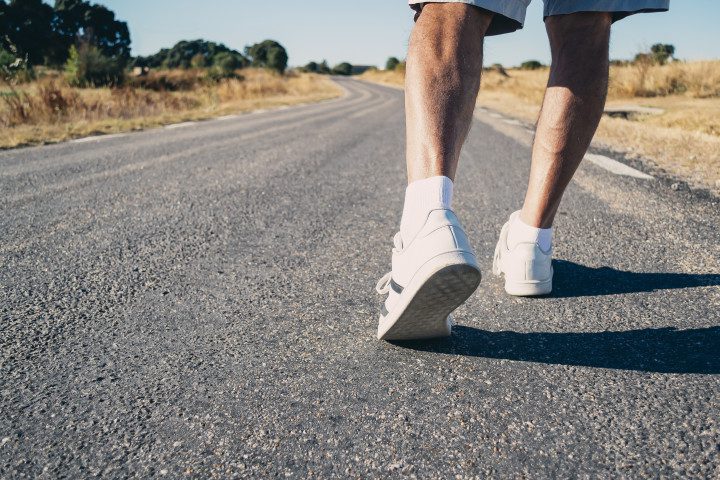Testosterone is a vital hormone that plays a critical role in several bodily functions, especially in the male body.
Its importance cannot be overstated, as it contributes to muscle mass, bone density, hair growth, and, more importantly, it influences mood and energy levels.
A common question that arises in discussions around maintaining and enhancing testosterone levels is: does walking increase testosterone?
This question is based on the premise that physical activity, even as simple and low-intensity as walking, could stimulate the body’s hormonal balance.
In this article, we will explore this connection, discussing how walking fits into the broader picture of testosterone production and the synergistic relationship it may harbor with our body’s physiology.
Walking as a Low-Intensity Workout
Walking is often underestimated as a form of exercise, primarily because it is a low-intensity workout.
However, its impact on overall health and hormonal balance is significant.
It’s a universally accessible form of exercise that doesn’t require any special equipment or training. Regular walking can improve heart health, increase lung capacity, and promote general well-being. But, does walking increase testosterone?
The relationship between walking and testosterone levels is a topic of ongoing research.
However, one possible theory revolves around the impact of exercise on body fat.
Walking, as a form of low-intensity workout, can contribute to fat loss.
Maintaining a healthy body fat percentage is critical for testosterone production as excessive fat can lead to hormonal imbalances, including reduced testosterone levels.
Therefore, by helping individuals achieve and maintain a healthy body fat percentage, walking indirectly supports the body’s testosterone production.
This is not to suggest that walking alone will drastically increase testosterone levels.
Rather, it highlights the role of walking as part of a comprehensive approach to maintaining overall health, which includes keeping testosterone levels within a healthy range.
Moving forward, we will delve deeper into the studies conducted about the correlation between walking and testosterone levels to provide a more empirical perspective.
Studies on Walking and Testosterone Levels

Research on the direct impact of walking on testosterone levels has yielded mixed results.
For instance, a study published in the Journal of Endocrinological Investigation found no significant effect of a 30-minute walk on testosterone levels in healthy men.
However, another study published in the European Journal of Applied Physiology reported an acute increase in testosterone following moderate-intensity walking in older men.
In the context of weight loss, walking exhibits a more indirect, yet essential, relationship with testosterone levels.
A study in the Journal of Clinical Endocrinology and Metabolism found that overweight and obese men who lost weight through lifestyle modification, including regular walking, experienced an increase in testosterone levels.
These studies highlight the complexity of the relationship between walking and testosterone levels, suggesting that it may be influenced by a range of factors, including age, initial testosterone levels, and body weight.
While walking may not directly boost testosterone in all cases, its role in promoting a healthy body weight could indirectly support testosterone production.
Therefore, walking can be part of a comprehensive lifestyle regimen aimed at maintaining healthy testosterone levels.
However, more research is needed to fully understand the specific mechanisms involved.
Does Walking Increase Testosterone Levels?

In addressing the main question, “does walking increase testosterone?”, it’s important to remember that the answer isn’t straightforward.
As we’ve discussed, studies regarding the direct impact of walking on testosterone levels have shown mixed results.
Some research suggests a modest increase in testosterone levels in certain populations, such as older men, following moderate-intensity walking.
On the other hand, some studies found no significant change in testosterone levels after walking.
However, it’s crucial to note the indirect benefits of walking in relation to testosterone levels. This primarily stems from the role walking plays in weight loss and management.
Walking, as a low-intensity workout, can help individuals lose fat and achieve a healthy body-fat percentage.
This is key for maintaining and potentially raising testosterone levels, as excessive body fat is linked to hormonal imbalances, including reduced testosterone.
In summary, while walking may not directly lead to a significant increase in testosterone for everyone, it does contribute to creating an overall healthier body environment that is conducive to maintaining optimal testosterone levels.
This is particularly useful for overweight individuals who are looking to lose fat and improve hormonal balance.
As with any health and fitness-related question, individual results may vary.
Therefore, it’s beneficial to incorporate walking into a holistic approach toward health and wellness, which includes a balanced diet, regular exercise, adequate sleep, and stress management.
This comprehensive strategy is likely to have a more substantial impact on testosterone levels than walking alone.
Remember, walking is a piece of the puzzle, not a magic bullet when it comes to hormonal health and testosterone levels.
Walking and Weight Loss

The link between walking and weight loss is well-established. Walking is a practical, low-impact exercise that can be easily incorporated into most people’s daily routines.
It burns calories, and when combined with a healthy diet, it can help create a calorie deficit, leading to weight loss.
Walking can also improve metabolic health, which can aid weight loss efforts.
A study published in the Journal of Exercise Nutrition & Biochemistry found that regular walking could significantly decrease body fat and visceral adipose tissue, particularly in obese individuals.
The connection between body fat and testosterone levels is crucial here.
Excess body fat is associated with reduced testosterone levels, as it can interfere with the hormones that trigger testosterone production.
By helping to reduce body fat, walking can indirectly play a role in supporting healthy testosterone levels.
Importantly, the key to successful weight loss through walking is consistency and persistence.
It may take time to see noticeable changes, but the cumulative benefits of regular walking extend beyond weight loss to encompass overall physical health, mental wellbeing, and hormonal balance.
In conclusion, walking, as a low-intensity workout, can contribute significantly to weight loss, which, in turn, can help maintain a healthy level of testosterone.
The process is not immediate, but the long-term benefits make it an essential part of a holistic approach to health and fitness.
Other benefits of walking
- Improves cardiovascular health: Regular walking can help lower the risk of heart disease and stroke by improving heart rate and reducing levels of bad cholesterol.
- Boosts mood and mental health: Studies have shown that walking, especially in natural settings, can reduce anxiety, depression, and negative mood. It also boosts self-perception and self-esteem.
- Strengthens muscles and bones: Walking is a weight-bearing exercise that can help in preventing osteoporosis and improving muscle strength and endurance.
- Improves sleep: Physical activity like walking, particularly in the morning, can improve sleep quality by regulating the body’s internal clock.
- Increases creativity and productivity: Walking helps clear the mind, improves concentration, and can boost creativity and productivity.
- Supports joint health: Walking helps to lubricate the joints, which can reduce pain and stiffness associated with conditions like arthritis.
- Increased testosterone production through nature exposure: Spending time outdoors in nature during your walks can contribute to increased testosterone production. A study published in the Journal of Environmental Psychology found that being in nature can increase vitality and feelings of positivity, which in turn can stimulate testosterone production.
Conclusion
In revisiting the main question, “Does walking increase testosterone?”, we find that the answer is nuanced.
While there isn’t a direct, universally applicable correlation between walking and increased testosterone levels, research does suggest potential benefits for certain groups such as older men and individuals engaged in weight loss efforts.
Walking excels as a low-intensity workout that can assist in fat loss and the achievement of a healthy body fat percentage.
This is important as a balanced body composition is key to maintaining and potentially enhancing testosterone levels.
Additionally, walking contributes to overall health and wellness, creating an environment within the body that is conducive to hormonal balance.
However, it’s crucial to underscore that walking should not be viewed as a standalone solution but as part of a holistic approach towards sustaining healthy testosterone levels.
Other lifestyle modifications, including a balanced diet, regular exercise, sufficient rest, and stress management, also play significant roles in hormonal health.
Finally, given that individual experiences may vary and the potential complexity of hormonal issues, it is advisable to seek the advice of a healthcare professional when setting out to improve testosterone levels.
Remember, taking care of your health is a marathon, not a sprint, and every positive step, including regular walking, is a valuable contribution to your health journey.
Frequently Asked Questions (FAQs)
How often should I walk to potentially increase testosterone levels?
While there’s no one-size-fits-all answer, a good starting point might be 30 minutes of brisk walking per day, most days of the week. However, remember that factors such as your current fitness level, age, and overall health will influence what is right for you.
Does the speed of walking impact testosterone levels?
Current research doesn’t provide a clear answer to this. While brisk walking appears to have more health benefits overall, it’s not clear if walking speed directly affects testosterone levels.
Will I see an immediate increase in my testosterone levels after starting walking?
The process is not immediate. The benefits of walking, including potential testosterone level enhancement, are more likely to be observed over the long-term.
Can I rely solely on walking to increase my testosterone levels?
No, walking should be viewed as a part of a holistic approach toward maintaining healthy testosterone levels, and not as a standalone solution. Other lifestyle modifications, such as a balanced diet, regular exercise, sufficient rest, and stress management, also play significant roles in hormonal health.
I’m overweight. How can walking help me?
Walking, as a low-intensity workout, can contribute significantly to weight loss, which, in turn, can help maintain a healthy level of testosterone. It is particularly useful for overweight individuals looking to lose fat and improve hormonal balance.
Does walking have the same effect on testosterone levels in men and women?
Testosterone is present in both men and women, but the levels and how it’s used in the body differ between sexes. More research is needed to fully understand the specific impact of walking on testosterone levels in women.
Are there any other natural ways to boost testosterone?
Yes, apart from walking and other physical activities, certain dietary choices, getting sufficient sleep, and managing stress levels can also contribute to maintaining healthy testosterone levels.
References
- Frajese, G. V., De Martino, M. U., Berardinelli, R., Guadagni, F., De Martino, B. (2011). Physical Exercise-Induced Late Onset Hypogonadism: Clinical Findings and Hormonal Responses to Different Testosterone Replacement Treatments in Aging Male Patients. Journal of Endocrinological Investigation, 34(3), e78-e83.
- Hayes, L. D., Herbert, P., Sculthorpe, N. F., Grace, F. M. (2017). Exercise training improves free testosterone in lifelong sedentary aging men. European Journal of Applied Physiology, 117(7), 1259-1267.
- Corona, G., Mannucci, E., Fisher, A. D., Lotti, F., Petrone, L., Balercia, G., Bandini, E., Forti, G., Maggi, M. (2008). Low Levels of Androgens in Men With Erectile Dysfunction and Obesity. Journal of Clinical Endocrinology and Metabolism, 93(10), 3870-3873.







